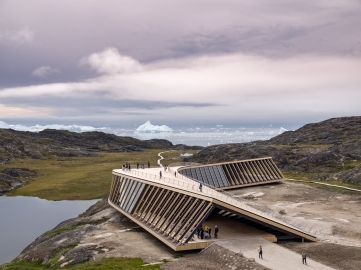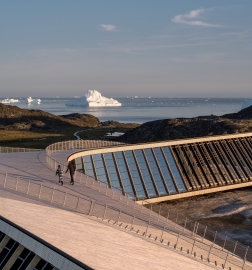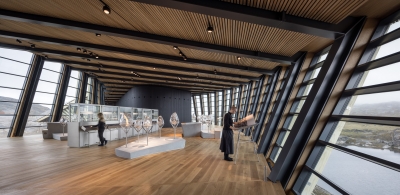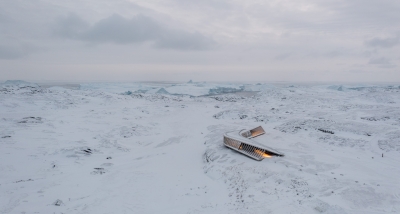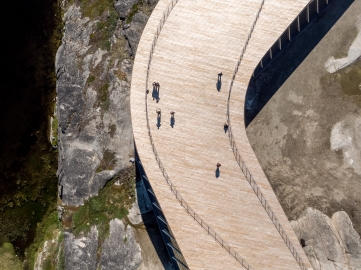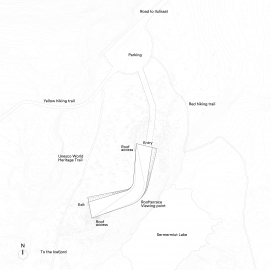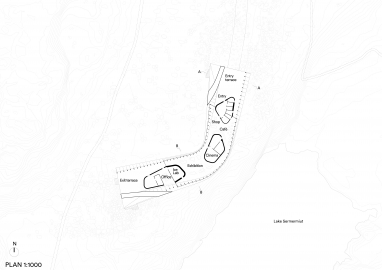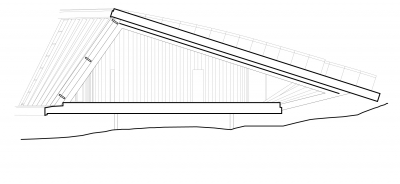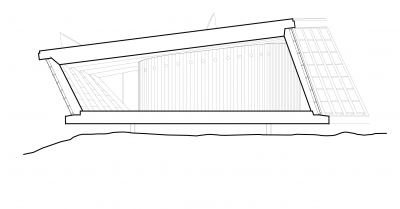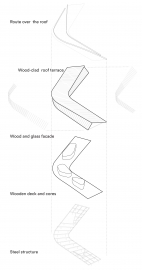Ilulissat Icefjord Centre
Kangiata Illorsua creates a shelter, gathering place and vantage point in the Arctic landscape between the UNESCO-protected Icefjord and small town Ilulissat. Combining architecture, art and science, the building conveys the significance of the unique landscape and provides a new perspective on Greenlandic Inuit culture, nature and climate change
Kangiata Illorsua is located 250 kilometres north of the Arctic Circle near the UNESCO-protected Kangia Icefjord where 35 cubic km ice yearly calves from the icecap at the rapidly retracting Sermeq Kujalleq glacier and floats towards the Disco Bay, making it one of the world’s most important places for monitoring climate change. The center aims to expand our knowledge on climate change, the influence of the retracting icecap, the unique natural and cultural history of Ilulissat, and contribute to a positive societal development and growing Inuit identity. The building sits lightly on the terrain. The roof provides a natural extension to the existing hiking routes and creates an accessible gathering place, a collective shelter, and a viewpoint. Inside, visitors can reflect on the story of ice and the Inuit culture while experiencing the vastness of the surrounding landscape.
Kangiata Illorsua was initiated through an international competition to establish a visitor centre – a natural connection between Ilulissat and the Icefjord and a meeting-, knowledge- and learning place for locals and visitors alike. The building is created through throughout analysis of the context – the geology, climate and culture, wind, ice, snow, and the Inuit knowledge of survival. Analysed in a wind tunnel, the curvature allows the wind to clear the façade from snow, preventing snow-build-up, and at the same time allowing visitors inside as well as walking the roof to get the first view of the Icefjord. The structure is carefully placed on stilts to protect the bedrock and the fragile flora and fauna while allowing melt water to follow the natural path to the lake. By creating a destination in the vast landscape, Kangiata Illorsua becomes an important place of information for tourists, and a unique gathering place for visitors, politicians, researchers, and the local community to meet and share knowledge. With unlimited access, the roof and covered spaces are already widely used by locals for social and celebratory gatherings, events, and informal meetings.
Conditions in the Arctic are challenging and working responsibly with the environment has been a profound focus. To ensure a durable and lightweight building, the load-bearing structure is steel enforced, consisting of 52 prefabricated frames, each with a unique geometric shape. Around 80 % of the steel is recycled and reusable. Due to thawing permafrost, the steel warrant less maintenance, fewer replacements and generally a longer lifespan in the now volatile climate. The resilient European oak is chosen for the majority of the construction, interior cladding and flooring with Accoya Wood at fascia edges and windows, lowering the carbon footprint. With 3-layer energy glass, the façade gains from passive heating in the summer month. The remoteness of the site and lack of naturally sourced building materials in Greenland underlines the importance of meticulously planning, calculating, designing and testing all in advance. The building was shipped, mounted in four months by local contractor and completed within planned time and budget. The building runs on CO2 neutral heating and electricity powered by the hydroelectric power plant in Ilulissat.

